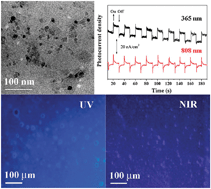A novel and simple approach for preparing graphene quantum dots surface-passivated by polyethylene glycol (GQDs-PEG) has been developed by a one-pot hydrothermal reaction, using small graphene oxide (GO) sheets and polyethylene glycol (PEG) as starting materials. The prepared GQDs-PEG show excellent luminescence properties, the PL quantum yield of the GQDs-PEG with 360 nm emission was about 28.0%, which was two times higher than the pure GQDs. Interestingly, the GQDs-PEG possess the upconversion photoluminescence (UCPL) properties. Blue PL was clearly shown both under the ultraviolet and 808 nm laser in the fluorescent microscopy images. So the GQDs-PEG may provide a new type of fluorescence and upconversion material for applications in bioscience and energy technology. Especially, the GQDs-PEG showed higher photocurrent generation capability. And their photoelectrode generated an obvious and stable photocurrent under a 808 nm near-infrared (NIR) laser. Due to the low cost and simple method, GQDs-PEG thus provide a cost-effective dopant material for solar energy conversion.

You have access to this article
 Please wait while we load your content...
Something went wrong. Try again?
Please wait while we load your content...
Something went wrong. Try again?


 Please wait while we load your content...
Please wait while we load your content...